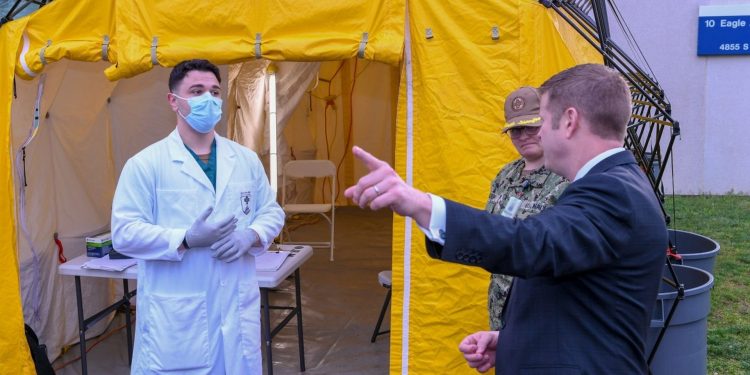The U.S. Army Medical Research and Development Command and U.S. Army Medical Research Institute of Infectious Diseases are aiding in the development of five separate COVID-19 vaccines, Secretary of the Army Ryan D. McCarthy announced Thursday.
In support of the federal government’s plan to combat the virus, the Army received an additional $900 million in funding to help prevent, detect, and treat the disease, McCarthy said.
“We got to spend a few hours with extraordinary Americans who are at the forefront of this fight. We are giving them all the resources that they can try … to help knock down any roadblocks in their path,” McCarthy said about his visit to Fort Detrick, Maryland.
The Army is doing all it can to assist the global medical community as they work together to defeat COVID-19, Army Chief of Staff Gen. James McConville said. The force is also monitoring several dozen vaccine candidates that are currently under development by the public and private sectors.
“The heroes are in this fight. These scientists are working to find a vaccination … working to find the drugs for treatment … and are aggressively increasing the capacity of our testing capabilities,” McConville said.
During their visit to USAMRDC and USAMRIID, the Army’s top leaders witnessed the force’s ongoing effort to fight against the disease, McCarthy said. Army leaders also received an update on the first Soldier to come down with the virus in South Korea.
While McCarthy did not share the information about the Soldier’s current condition, he did indicate that the virus has put him and his family under a lot of stress.
PREPARING TO FIGHT
Currently, the National Guard is assisting the states as the active-duty force aligns its personnel and resources for when it is called upon to support, McConville said.
The Army is prepared to provide Army medical support to civilian communities, McConville said.
Deployable Army medical units “were designed for combat-type operations … not designed for infectious diseases,” McConville said. Expeditionary military medical capabilities can help take some of the load off, “allowing the civilian hospitals to focus on the issue.”
Army leaders are also working to mitigate risk, McConville said. The majority of the Guard and Army Reserve’s medical personnel are already working in their communities to combat COVID-19.
“If we call them up, the Reserves, we may be taking them out of the very communities that we’re trying to help,” McConville said.
Along with the Army’s effort to support the medical field, the U.S. Army Corps of Engineers is currently working with four state governors, including the governor of New York, to develop alternative hospital facilities.
“We are offering these governors options,” McConville said. “We think the fastest way is to take hotels and dormitories that are available and re-scope them” into medical facilities.
Altering a pre-existing facility to support the Army’s mission is not uncommon, McConville said. During World War II, for example, the Army used the Greenbrier hotel in White Sulphur Springs, West Virginia, as a Soldier surgery and rehabilitation center.
“Large open tents are not the best place to put people with infectious diseases,” McConville said. “We are giving (the governors) some options that they can work with.”











